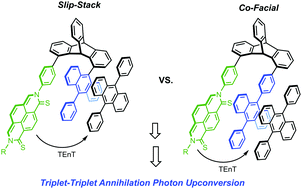Triplet photodynamic and up-conversion luminescence in donor–acceptor dyads with slip-stacked vs. co-facial arrangement†
Abstract
The design/synthesis and characterization of organic donor–acceptor (D–A) dyads can provide precious data allowing to improve the efficiency of classical photo-induced bimolecular interactions/processes. In this report, two novel triplet D–A dyads (4 and 5) were synthesized and fully characterized. While the optical absorption and emission profiles of these new systems exhibit similar spectral structures as that of the triplet donor/sensitizer quinoidal thioamide (QDN), the transient absorption (TA) spectra of these two dyads produced new features that can be associated with triplet transients and charge transfer species. However, the kinetics of the excited-state processes/dynamics is significantly influenced by the geometrical arrangement(s) of donor/acceptor chromophores. Further analysis of the TA data suggests that the dyad with slip-stack geometry (4) is less effective in undergoing both intra- and inter-dyad triplet energy transfer than the dyad with co-facial geometry (5). Subsequently, triplet sensitization of 9,10-diphenylanthracene (DPA) using both dyads led to upconverted photoluminescence via triplet–triplet annihilation of DPA triplet transients. But, it was found that a maximum upconversion quantum yield could be achieved at a low power density using the co-facial type dyad 5. Altogether, these results provide valuable guidance in the design of triplet donor–acceptor dyads, which could be used for light-harvesting/modulation applications.

- This article is part of the themed collection: Materials for thermally activated delayed fluorescence and/or triplet fusion upconversion


 Please wait while we load your content...
Please wait while we load your content...
